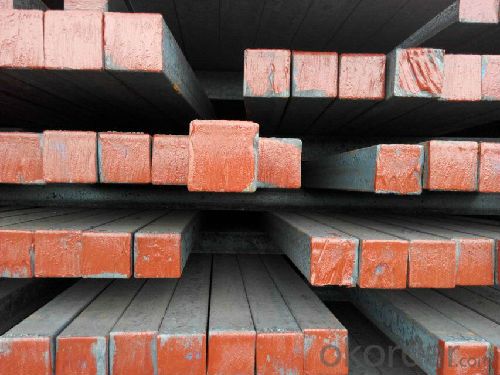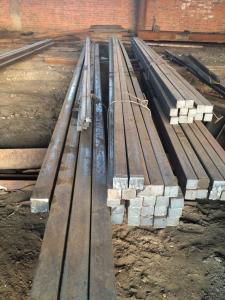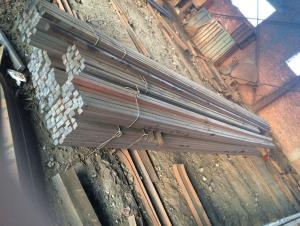Hot Rolled Steel Square Bar Q235, A36 SS400
- Loading Port:
- China main port
- Payment Terms:
- TT or LC
- Min Order Qty:
- 25 m.t.
- Supply Capability:
- 200000 m.t./month
OKorder Service Pledge
OKorder Financial Service
You Might Also Like
Product Description:
OKorder is offering Hot Rolled Steel Square Bar Q235, A36 SS400 at great prices with worldwide shipping. Our supplier is a world-class manufacturer of steel, with our products utilized the world over. OKorder annually supplies products to European, North American and Asian markets. We provide quotations within 24 hours of receiving an inquiry and guarantee competitive prices.
Product Applications:
High Qualty Hot Rolled Steel Square Bar Q235, A36 SS400 are ideal for structural applications and are widely used in the construction of buildings and bridges, and the manufacturing, petrochemical, and transportation industries.
Product Advantages:
OKorder's Hot Rolled Steel Square Bar Q235, A36 SS400 are durable, strong, and resist corrosion.
Main Product Features:
· Premium quality
· Prompt delivery & seaworthy packing (30 days after receiving deposit)
· Corrosion resistance
· Can be recycled and reused
· Mill test certification
· Professional Service
· Competitive pricing
Product Description:
Specifications of Q235, A36 High Qualty Hot Rolled Steel Square Bar :
-Standard: GB,
-Grade: Q195/Q235 or equivalent.
-Chemical Composition:
Standard | Grade | Element (%) | ||||
C | Mn | S | P | Si | ||
GB | Q195 | 0.06~0.12 | 0.25~0.50 | ≤0.050 | ≤0.045 | ≤0.30 |
GB | Q235B | 0.12~0.20 | 0.30~0.70 | ≤0.045 | ≤0.045 | ≤0.30 |
-Mechanical Properties:
Mechanical Properties | Grade | Steel diameter(mm) | |||
≤16 | 16~40 | 40~60 | 60~100 | ||
Yield Point Δs/MPa | Q195 | ≥195 | ≥185 | - | - |
Q235 | 235 | 225 | 215 | 205 | |
Tensile Strength | Q195 | 315~390 | |||
Q235 | 375~500 | ||||
Elongation δ5% | Q195 | ≥33 | ≥32 | - | - |
Q235 | 26 | 25 | 24 | 23 | |
Measures of High Qualty Hot Rolled Steel Square Bar GB, ASTM, JIS Standard:
-Length of a side and Theoretical weight of Square Bar (Big measures).
Length of a side(mm) | Theoretical weight(kg/m) | Length of a side(mm) | Theoretical weight(kg/m) |
53 | 22.05 | 80 | 50.24 |
56 | 24.61 | 85 | 56.72 |
60 | 28.26 | 90 | 63.59 |
63 | 31.16 | 95 | 70.85 |
70 | 38.49 | 100 | 78.50 |
75 | 44.16 |
Notes:
1, The theoretical weights in the list, base on the density of 7.85 g/cm3.
2, Formula for theoretical weight of Square bar: a(length of a side) * a * 0.00785
3, The numbers with *mean that they are not regular or we don’t offer them.
-Regular length of Square Bar:
Steel | Length of a side (mm) | Length of steel (m) |
Normal steel | < 25 | 4~10 |
> 25 | 3~9 | |
Steel of high quality | All measure | 2~6 |
Tool steel >75 | 1~6 |
Usage/Applications of High Qualty Hot Rolled Steel Square Bar GB, ASTM, JIS Standard:
-The Square Steel is normally used as structure steel.
-Row material for other structure steel like steel angles, channels, I-beams, H-beams, etc…
-Row material for steel pipes.
Packaging & Delivery of High Qualty Hot Rolled Steel Square Bar GB, ASTM, JIS Standard:
-Packing Detail:
1, The products can be packed in bundles by steel wires.
2, The weight of each bundle no exceed normally 3 tons.
-Marks: We make tag marks and color marks for each bundle. The tag marks with white background and red company log will be tied up to each bundle. The information is usually including basic information of company and products like product name, specification, etc...and other information required by customers. As for color marks, we will paint both ends of each bundles to make sure that it will be more convenient for customers to distinguish theme from other products.
-Delivery Detail: 30~45 working days after receive buyer’s T.T. or L/C.
Payment:
-Invoicing on theoretical weight or actual weight as customer’s request.
-FOB, CFR or CIF.
-Regular terms of payment:
1, 30% payment in advance, the remaining balance (70% payment) against the copy of B/L.
2, 30% payment in advance, the remaining balance (70% L/C) against the copy of B/L.
3, Negotiable.
-The payment terms will be written in contraction detailedly.
We sincerely welcome partners around the world to establish business cooperation with us on the basis of mutual trust, benefit and development.
FAQ:
Q1: Why buy Materials & Equipment from OKorder.com?
A1: All products offered byOKorder.com are carefully selected from China's most reliable manufacturing enterprises. Through its ISO certifications, OKorder.com adheres to the highest standards and a commitment to supply chain safety and customer satisfaction.
Q2: What makes stainless steel stainless?
A2: Stainless steel must contain at least 10.5 % chromium. It is this element that reacts with the oxygen in the air to form a complex chrome-oxide surface layer that is invisible but strong enough to prevent further oxygen from "staining" (rusting) the surface. Higher levels of chromium and the addition of other alloying elements such as nickel and molybdenum enhance this surface layer and improve the corrosion resistance of the stainless material.
Q3: Can stainless steel rust?
A3: Stainless does not "rust" as you think of regular steel rusting with a red oxide on the surface that flakes off. If you see red rust it is probably due to some iron particles that have contaminated the surface of the stainless steel and it is these iron particles that are rusting. Look at the source of the rusting and see if you can remove it from the surface.
Images:


- Q:How is a steel square different from a framing square?
- A steel square and a framing square are both versatile tools used in carpentry and construction, but they have different designs and purposes. A steel square, also known as a rafter square or carpenter's square, is a small, handheld tool typically made of steel. It consists of two arms, a shorter one called the tongue and a longer one called the blade, meeting at a right angle. The blade usually has scales and markings to measure angles and lengths. Steel squares are primarily used for measuring and marking right angles, determining the squareness of corners, and laying out or checking angles for cuts. They are commonly used in tasks that require precision, such as framing, roofing, and stair construction. On the other hand, a framing square, also called a carpenter's square, is a larger tool typically made of aluminum or steel. It consists of a long arm called the blade and a shorter arm called the tongue, joined together at a right angle. The blade is wider and often has multiple scales and markings for measuring different angles, lengths, and cuts. Framing squares are primarily used in rough carpentry and framing applications, such as laying out and marking rafters, stairs, or walls. They are essential for ensuring accurate and consistent measurements and cuts in larger-scale construction projects. In summary, while both a steel square and a framing square are useful tools in carpentry and construction, they differ in size, design, and purpose. A steel square is smaller, handheld, and primarily used for measuring and marking right angles, while a framing square is larger, often with multiple scales, and used in rough carpentry tasks to ensure precise measurements and cuts.
- Q:How do you use a steel square to ensure the correct angle for a half-lap joint?
- To use a steel square to ensure the correct angle for a half-lap joint, follow these steps: 1. Start by marking the desired depth of the half-lap joint on both pieces of wood that will be joined together. This can be done by measuring and marking the depth on the edge of each piece. 2. Place the steel square on the end of one of the pieces of wood, aligning it with the edge and ensuring that the inside corner of the square is facing towards the end of the wood. 3. Use a pencil or a marking knife to trace along the inside edge of the steel square. This will create a straight and square line across the end of the wood. 4. Repeat the process on the other piece of wood, making sure the lines are aligned when the two pieces are placed together. 5. Now, you can use a handsaw or a chisel to remove the material between the lines on both pieces of wood. Make sure to cut along the lines accurately to achieve a tight and precise fit. By using a steel square to mark the lines, you can ensure that the angles of the half-lap joint are correct and the joint will fit together accurately. The steel square acts as a guide to create straight and square lines, making it easier to achieve the desired angle for the joint.
- Q:How do you use a steel square to lay out a birdsmouth cut?
- In order to lay out a birdsmouth cut using a steel square, the dimensions required for the cut must first be determined. A birdsmouth, which is a notch or cutout made on the top edge of a rafter to securely rest on a wall or supporting structure, can be achieved by following these step-by-step instructions: 1. Determine the desired depth of the birdsmouth cut on the rafter and mark it accordingly. Typically, this is based on the thickness of the supporting structure it will be placed on. 2. Align the longer leg (blade) of the steel square with the edge of the rafter, ensuring that the shorter leg (tongue) extends beyond the rafter's width. 3. Slide the square along the rafter until the desired length of the birdsmouth cut is achieved. The point where the blade meets the rafter edge should align with the marked depth. 4. Securely hold the square in position and use a pencil or scribe to trace along the tongue's edge. 5. Without moving the square, rotate it so that the tongue aligns with the rafter's edge and the blade extends beyond the width of the rafter. 6. Slide the square along the rafter until the desired cut length is reached, ensuring that the point where the tongue meets the rafter edge aligns with the marked depth. 7. Once again, securely hold the square in place and use a pencil or scribe to trace along the blade's edge. 8. The resulting traced lines will form an L-shape on the rafter, outlining the birdsmouth cut. 9. Carefully use a saw to cut along the traced lines, ensuring to stay within the lines and maintain the desired dimensions. By following these instructions, a steel square can be effectively utilized to lay out and cut a birdsmouth, resulting in a precise fit for the rafter on the supporting structure.
- Q:What are the different features of a steel square?
- A steel square typically consists of a flat steel blade and a perpendicular steel handle. It has various features, including a right-angle feature, marked at 90 degrees, which allows for precise measurements and angles. It also often includes a 45-degree feature, marked at 45 degrees, for measuring and marking accurate diagonal lines or angles. Additionally, it may have a ruler or measuring scale along the blade, enabling measurements for length, width, or depth. Some steel squares may feature an adjustable sliding blade, allowing for versatility in various woodworking or construction tasks. Overall, the different features of a steel square make it a versatile and essential tool for precise measurements and marking in various projects.
- Q:Can a steel square be used for checking the squareness of picture frames?
- Yes, a steel square can be used for checking the squareness of picture frames. The straight edges and right angles of the steel square can be aligned against the corners of the frame to ensure that it is perfectly square.
- Q:Can a steel square be used for cutting or shaping materials?
- No, a steel square is not designed for cutting or shaping materials. It is primarily used as a measuring and marking tool in carpentry and woodworking to ensure accurate right angles and straight lines.
- Q:How do you use a steel square to determine the slope of a wheelchair ramp?
- To determine the slope of a wheelchair ramp using a steel square, you would place one side of the square against the surface of the ramp and the other side vertically. Then, you can measure the height of the vertical side and the length of the horizontal side. By dividing the height by the length and multiplying by 100, you can determine the slope percentage of the ramp.
- Q:Can a steel square be used for marking out dovetail joints?
- Yes, a steel square can be used for marking out dovetail joints. A steel square is a versatile tool that can be used for measuring and marking angles accurately, making it suitable for marking out the precise angles required for dovetail joints.
- Q:How do you use a steel square for marking and cutting angled bridle joints?
- To use a steel square for marking and cutting angled bridle joints, follow these steps: 1. Understand the concept: A bridle joint is a type of woodworking joint where two pieces of wood intersect at a right angle. The ends of each piece are cut at a 45-degree angle, creating a V-shaped notch. The steel square helps ensure accurate markings and cuts for this joint. 2. Mark the wood: Begin by measuring and marking the desired length of your joint on each piece of wood. Use a measuring tape and pencil to make precise markings. 3. Set the steel square: Position the steel square on the end of one piece of wood, aligning it with the edge. Ensure that the 45-degree angle is facing inward towards the center of the wood. 4. Mark the angles: Use a pencil or marking knife to trace the inside of the steel square along the 45-degree angle. This will create a straight and precise line that represents the angled cut to be made. 5. Repeat on the other piece: Flip the steel square and repeat the marking process on the end of the second piece of wood. Ensure that the angles match up perfectly when the two pieces are placed together. 6. Cut the joint: With the marks made, use a saw to cut along the marked lines on each piece of wood. Take your time and make precise cuts to ensure a clean joint. 7. Test the fit: Once both pieces are cut, test the fit by joining them together. The angled cuts should create a tight and secure joint. Make any necessary adjustments if the fit is not perfect. By using a steel square to mark and cut angled bridle joints, you can achieve accurate and precise results, ensuring a strong and visually appealing joint in your woodworking project.
- Q:Can a steel square be used for checking the plumbness of columns?
- No, a steel square cannot be used for checking the plumbness of columns. A steel square, also known as a framing square, is a tool primarily used in carpentry and woodworking for measuring and marking right angles. It is not designed or calibrated for vertical alignment or determining the plumbness of objects such as columns. To check the plumbness of columns, a plumb bob or a level would be more suitable tools. A plumb bob is a pointed weight that hangs from a string, allowing for precise vertical alignment. By observing the position of the plumb bob in relation to the column, one can determine if it is perfectly plumb or if any adjustments need to be made. Alternatively, a level can also be used to check the plumbness of columns. A level is a tool with a liquid-filled tube and a bubble that indicates whether a surface is level or plumb. By placing the level against the column and observing the position of the bubble, one can determine if the column is perfectly vertical or if any adjustments are required.
1. Manufacturer Overview |
|
|---|---|
| Location | |
| Year Established | |
| Annual Output Value | |
| Main Markets | |
| Company Certifications | |
2. Manufacturer Certificates |
|
|---|---|
| a) Certification Name | |
| Range | |
| Reference | |
| Validity Period | |
3. Manufacturer Capability |
|
|---|---|
| a)Trade Capacity | |
| Nearest Port | |
| Export Percentage | |
| No.of Employees in Trade Department | |
| Language Spoken: | |
| b)Factory Information | |
| Factory Size: | |
| No. of Production Lines | |
| Contract Manufacturing | |
| Product Price Range | |
Send your message to us
Hot Rolled Steel Square Bar Q235, A36 SS400
- Loading Port:
- China main port
- Payment Terms:
- TT or LC
- Min Order Qty:
- 25 m.t.
- Supply Capability:
- 200000 m.t./month
OKorder Service Pledge
OKorder Financial Service
Similar products
New products
Hot products
Related keywords

























